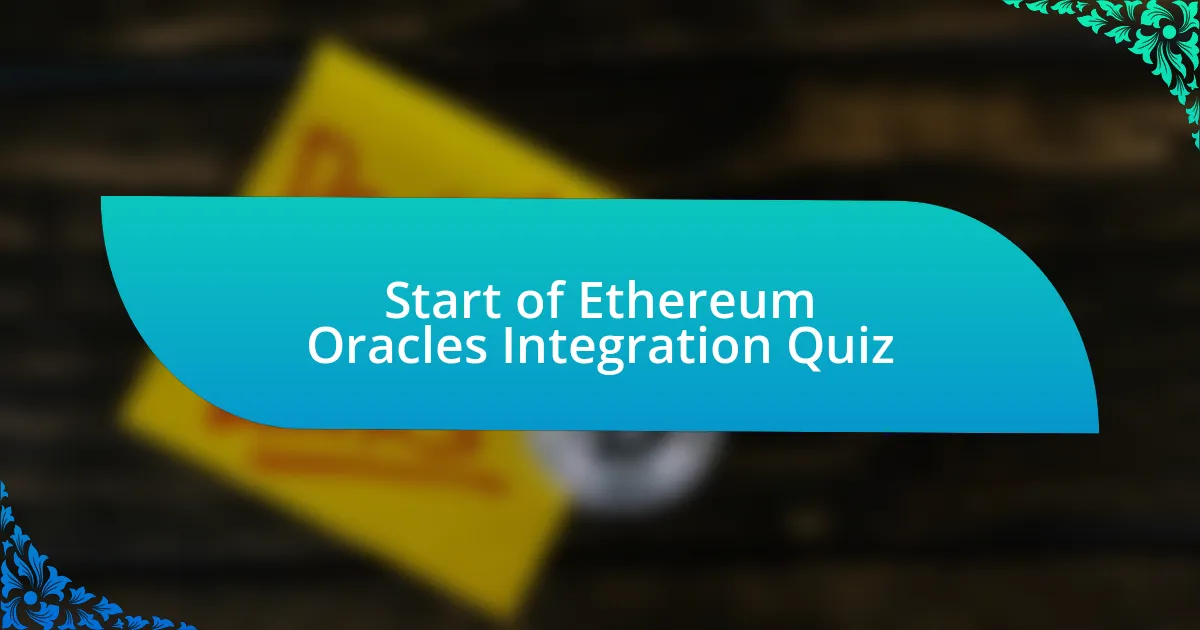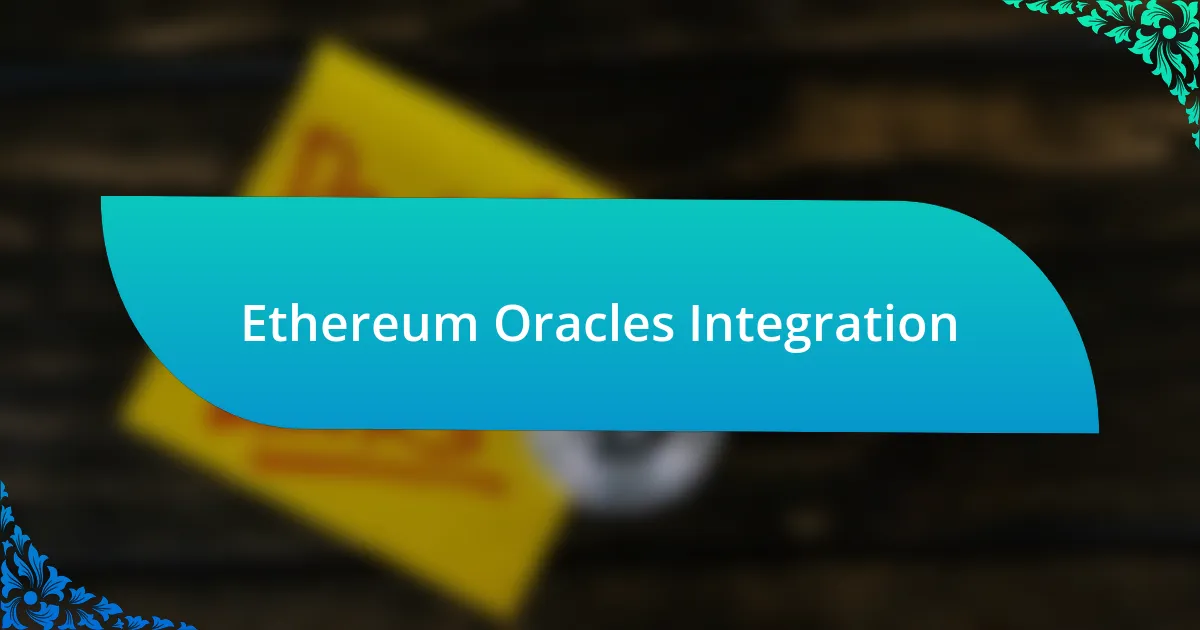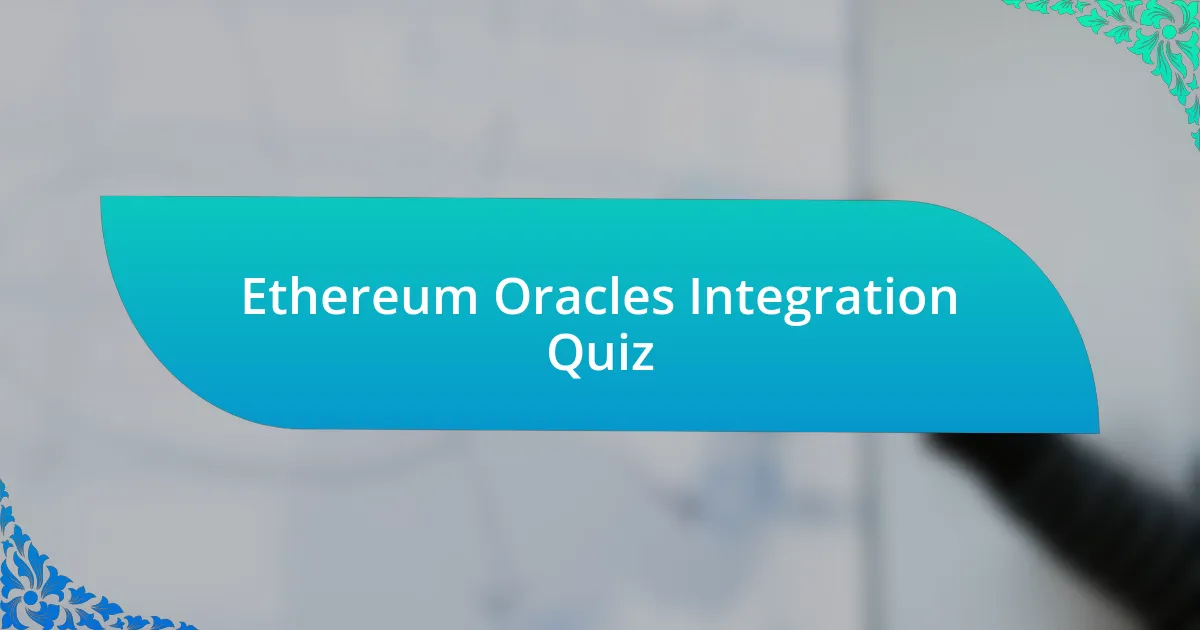
Start of Ethereum Oracles Integration Quiz
1. What is the primary function of an Ethereum oracle?
- To secure transactions between users.
- To provide external data to Ethereum smart contracts.
- To enhance the graphics of the blockchain interface.
- To create new cryptocurrencies on the platform.
2. What is the term for the problem of verifying the accuracy of data provided by oracles?
- The consensus issue.
- The data integrity challenge.
- The oracle problem.
- The trust dilemma.
3. How do oracles typically handle the challenge of ensuring data accuracy?
- By using mechanisms such as quorum systems and consensus protocols.
- By allowing any user to submit data without checks.
- By assuming all external data is inherently accurate.
- By relying solely on a single data source without verification.
4. What are the two main types of oracle design patterns used in Ethereum?
- Push-pull and subscribe-publish
- Listen-respond and react-update
- Call-fetch and notify-update
- Publish-subscribe and request-response
5. What is the purpose of the publish-subscribe oracle design pattern?
- To verify user identities before accessing smart contracts.
- To expose a data feed that other contracts can regularly read for information.
- To create backup storage for all smart contract data.
- To establish a secure transaction process for contracts.
6. What is the request-response oracle design pattern used for in Ethereum?
- To automatically execute smart contracts without user input.
- To handle specific requests for data from smart contracts.
- To predict future transactions in the network.
- To enforce contract terms based on user preferences.
7. How do oracles collect data from off-chain sources?
- By generating random numbers on-chain.
- By creating transactions for all users.
- By mining new blocks on-chain.
- By querying external APIs or databases.
8. How do oracles transfer data on-chain with a signed message?
- By simply sending plain text through the network.
- By encrypting data and storing it off-chain.
- By broadcasting the data to all nodes without authentication.
- By using transactions that include the data and a digital signature.
9. What is the role of the Ethereum Virtual Machine (EVM) in relation to oracles?
- The EVM ensures that smart contract execution is deterministic and based only on the shared context of the Ethereum state and signed transactions.
- The EVM is responsible for generating the external data used by oracles.
- The EVM provides a user interface for interacting with oracles.
- The EVM validates the accuracy of data before it reaches smart contracts.
10. Why are oracles necessary for Ethereum smart contracts?
- To enable real-time trading of cryptocurrencies on the platform.
- To provide a trustless way of getting extrinsic information onto the Ethereum platform.
- To secure transactions by eliminating the need for miners.
- To facilitate the creation of new cryptocurrencies in the Ethereum ecosystem.
11. What is the term for a system that can provide external data sources to Ethereum smart contracts?
- Oracle
- InfoLink
- SourceSync
- DataMiner
12. How do oracles make data available to smart contracts?
- By sending it through email to the contract.
- By encrypting it on the blockchain.
- By putting it in a smart contract’s storage.
- By logging it in an external database.
13. What are the key functions provided by all oracles?
- Extracting data from smart contracts and executing trades.
- Processing on-chain trades and managing user accounts.
- Storing blockchain transactions securely and verifying signatures.
- Collecting data from off-chain sources, transferring data on-chain with a signed message, and making data available in a smart contract’s storage.
14. What is an immediate-read oracle used for in Ethereum?
- To serve as a backup for smart contracts.
- To encrypt sensitive information for security.
- To permanently store data in the blockchain.
- To provide immediate access to data that is expected to change frequently.
15. How do publish-subscribe oracles handle frequent data changes?
- By shutting down when frequent changes occur to prevent overload.
- By automatically generating new data feeds each time there`s a change.
- By requiring user intervention to fetch the latest data manually.
- By having client contracts listen for updates to the data in the oracle’s storage.
16. What is the minimum number of responses required before declaring a final result in a quorum system?
- Exactly 1
- Typically 2 or more
- Exactly 4
- 3 or fewer
17. How do oracles handle requests for data in a request-response system?
- By directly inserting data without any requests.
- By ignoring the request and providing random data.
- By sending data only to authorized users without requests.
- By creating a request and having oracles respond with the requested data.
18. What is the purpose of the `NewRequest` event in an oracle contract?
- To trigger an event when a new request is created.
- To signal an update on an existing request.
- To confirm the validity of data from oracles.
- To enforce penalties for delayed responses.
19. What is the purpose of the `UpdatedRequest` event in an oracle contract?
- To log the creation of a data feed.
- To update the status of ongoing requests.
- To notify users about rejected requests.
- To trigger an event when there is a consensus on the final result.
20. How do oracles ensure that data is always available and updated regularly?
- By using random numbers for data updates.
- By implementing mechanisms like periodic updates and notifications.
- By relying solely on user inputs for updates.
- By storing data in a central server without updates.
21. What are some common challenges faced by oracles in providing accurate data?
- Verifying data accuracy
- Reducing smart contract complexity
- Increasing processing speed
- Ensuring low transaction fees
22. How do different oracles offer solutions to the oracle problem?
- By depending on random guesses and unverified inputs.
- By utilizing fixed data sources without verification.
- By relying solely on centralized databases and manual checks.
- By using various mechanisms such as quorum systems, consensus protocols, and data validation techniques.
23. What is the role of the `Request` struct in an oracle contract?
- To store historical data of requests made to the contract.
- To manage the voting process among oracles for consensus.
- To create a new smart contract on-chain.
- To define the structure of a request including the request ID, API URL, attribute to fetch, and agreed value.
24. How do oracles handle multiple oracles in a quorum system?
- By maintaining a mapping of oracles and their status (e.g., whether they have voted).
- By allowing any oracle to submit data without verification.
- By requiring all oracles to respond at exactly the same time.
- By using a random selection of oracles to provide data.
25. What is the purpose of the `updateRequest` function in an oracle contract?
- To delete an existing request in the oracle contract.
- To record an oracle`s answer to a specific request.
- To initiate a new request for data from an oracle.
- To verify the accuracy of data provided by oracles.
26. How do oracles ensure that only trusted oracles provide answers?
- By checking if the oracle is in the list of trusted oracles and if it hasn`t voted yet.
- By using random selection to choose which oracles to trust.
- By asking the oracle for proof of trust from other parties.
- By allowing any oracle to submit answers without checks.
27. What is the purpose of the `quorum` mapping in an oracle contract?
- To maintain a history of all contract transactions.
- To keep track of which oracles have voted and which have not.
- To decide the order of operations in the contract.
- To store the final results of previous requests.
28. How do oracles handle empty slots in the answers array?
- By deleting any empty slots to prevent data issues.
- By filling all empty slots with default values before saving.
- By finding the first empty slot and saving the retrieved value there.
- By ignoring the empty slots and proceeding with the next values.
29. What is the purpose of the `currentQuorum` variable in an oracle contract?
- To keep track of the number of oracles that have voted the same answer.
- To record the specific requests made by each oracle.
- To manage the timeout periods for oracle responses.
- To determine the order in which oracles respond.
30. How do oracles check for consensus among oracles?
- By analyzing the transaction fees paid by oracles to submit data.
- By checking the server uptime of each oracle involved.
- By iterating through the oracle list and checking if enough oracles have voted the same answer.
- By requiring oracles to provide proof of data sources used.

Congratulations! You’ve Successfully Completed the Quiz
Thank you for participating in our quiz on Ethereum Oracles Integration. We hope you found it informative and engaging. Quizzes like this one are a great way to deepen your understanding of complex topics. You may have learned about how oracles connect blockchain with real-world data, their essential role in decentralized applications, and the different types of oracles available.
Understanding Ethereum oracles is crucial in today’s blockchain ecosystem. They serve as a bridge to vital information beyond the blockchain. With this knowledge, you’re better equipped to explore innovations in smart contracts and decentralized finance.
We invite you to continue your learning journey. Check out the next section on this page, where you’ll find even more detailed information about Ethereum Oracles Integration. This will not only solidify your understanding but also enhance your ability to navigate the exciting world of decentralized technologies.

Ethereum Oracles Integration
Understanding Ethereum Oracles
Ethereum oracles are third-party services that provide smart contracts with external data. They serve as bridges between blockchain networks and the outside world, enabling the integration of real-time information into decentralized applications (dApps). This integration is crucial for applications that rely on events or data from outside the blockchain, such as stock prices, weather data, or sports scores. Oracles ensure that smart contracts can execute based on verified information, thereby extending the capabilities of blockchain technology beyond its inherent limitations.
The Role of Trusted Data Providers in Ethereum Oracles
Trusted data providers play a vital role in Ethereum oracles. They supply the necessary external data on which smart contracts depend to function accurately. The reliability of these data sources directly impacts the integrity of the smart contracts utilizing them. Data providers can be centralized or decentralized, with decentralized providers offering more resilience against manipulation. Examples include decentralized oracle networks like Chainlink, which aggregate data from multiple sources to ensure accuracy and minimize the potential for fraud.
Types of Ethereum Oracles
There are several types of Ethereum oracles. Soft oracles access publicly available data, while hard oracles interact with real-world systems. Consensus oracles aggregate data from multiple sources to achieve a reliable result. Additionally, candidate oracles leverage third-party APIs to provide data. Each type has its specific use cases and advantages, impacting the accuracy and security of the dApps relying on them. Understanding these distinctions is essential for developers looking to implement oracles in their projects.
Integration Challenges of Ethereum Oracles
Integrating Ethereum oracles presents several challenges. One significant issue is data accuracy; incorrect external data can lead to faulty contract execution. Security is another concern, as oracles can be vulnerable to attacks or manipulation. Additionally, latency in data transmission can affect the timeliness of the information received. Developers must address these challenges to build robust applications that depend on oracles, ensuring the reliability and security of the data being integrated.
Future Trends in Ethereum Oracle Integration
The future of Ethereum oracle integration is leaning towards greater decentralization and enhanced security measures. Innovations like decentralized autonomous organizations (DAOs) can contribute to the governance of oracles, establishing trust and reliability. Furthermore, advancements in cross-chain technology may facilitate oracle operations across different blockchain networks. As the demand for decentralized finance (DeFi) and other blockchain applications grows, the role of oracles will continue to evolve, adapting to meet the needs of the ecosystem.
What are Ethereum Oracles?
Ethereum Oracles are third-party services that provide external data to smart contracts on the Ethereum blockchain. They act as a bridge between blockchain networks and the outside world, allowing smart contracts to interact with real-world events and data. For example, they can supply price data, weather information, or event outcomes to decentralized applications (dApps). The usage of oracles is crucial for enabling functionalities in decentralized finance (DeFi) and other applications that require current and reliable data.
How do Ethereum Oracles work?
Ethereum Oracles work by fetching data from outside the blockchain and delivering it to smart contracts. They utilize various methods to pull this data, including APIs or data feeds. Upon retrieving the data, the oracle submits it to the Ethereum blockchain where the smart contracts can access it. An example is a price oracle that retrieves market prices and publishes them on-chain for decentralized exchanges to use in their trading algorithms.
Where are Ethereum Oracles used?
Ethereum Oracles are used across multiple industries, particularly in decentralized finance (DeFi), gaming, and supply chain management. In DeFi, they provide vital price feeds for trades and loans. In gaming, they can facilitate real-world outcomes affecting in-game scenarios. Furthermore, in supply chain management, oracles can track and verify product information and origin. Their versatility makes them a key component in various blockchain applications.
When should Ethereum Oracles be implemented?
Ethereum Oracles should be implemented when a smart contract requires external data to function correctly. This is essential in scenarios where trustless interactions are needed for the contract’s execution. For instance, when creating a decentralized finance application that depends on live cryptocurrency prices, integrating an oracle is necessary to ensure that the data used is reliable and updated in real-time.
Who develops Ethereum Oracles?
Ethereum Oracles are developed by both specialized companies and open-source communities. Notable examples include Chainlink, Band Protocol, and The Graph. These organizations create oracle solutions that provide specific functionalities like decentralized data feeds or aggregations. Their technologies allow for greater trust and reliability in data provision for Ethereum smart contracts.

